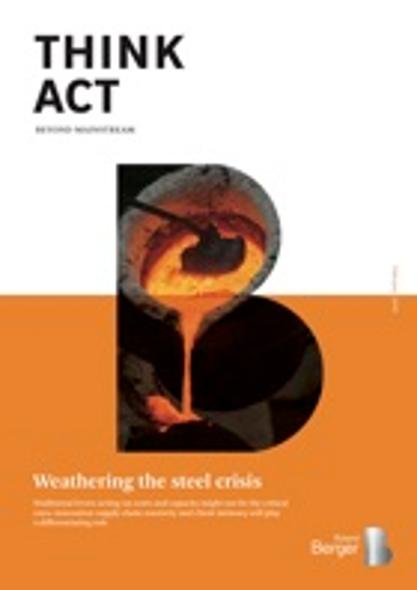Weathering the Steel Crisis
![{[downloads[language].preview]}](https://www.rolandberger.com/publications/publication_image/rb_weathering_download_preview.jpg)
Traditional levers acting on costs and capacity might not be the critical ones: innovation supply-chain reactivity and client intimacy will play a differentiating role


After a period of optimism in 2013 and 2014, the price of steel has decreased dramatically. Demand in China alone has fallen by 3.3%. While this was anticipated to some degree after a planned capacity increase in 2012, companies facing global overcapacity must find ways to emerge from this crisis more agile than ever before. They must also now consider the influence of the fourth industrial revolution. After interviews with industry experts and a survey of the crisis, we have identified four ways every component of the supply chain can further adapt, engage with new drivers, and increase profitability.

In the midst of the steel crisis, many companies have already begun to restructure or rethink their supply chains. These measures have proven to be wise starting points, but businesses must still further adapt. Through cost management and capex cuts, sell-offs and capacity closure, ongoing restructuring, and reorganized distribution, companies can look critically at their operations and take the next steps towards making necessary changes. Illustrated by industry examples and clear outlines for continuing the process, we discuss methods that have worked for some of the top producers in the industry and suggest new strategies for adapting and staying competitive. This could include adding retail components or specialized services.

Three new drivers of profitability have also emerged: client intimacy, increase in supply chain and commercial reactivity, and focusing on regional rather than global concerns. While the past has shown a preference for large operations, the answer today may indeed be an operation focused on efficiency and integration in the supply chain, customer needs, and specific hotspots. In the face of industry 4.0, where products will have shorter lifespans, shorter and more efficient turnaround times, more flexible production, and profit from Big Data customer insight, the steel industry can restructure around these concepts with a greater knowledge of their own needs and emerge from this crisis more dynamic than before.

![{[downloads[language].preview]}](https://www.rolandberger.com/publications/publication_image/rb_weathering_download_preview.jpg)
Traditional levers acting on costs and capacity might not be the critical ones: innovation supply-chain reactivity and client intimacy will play a differentiating role